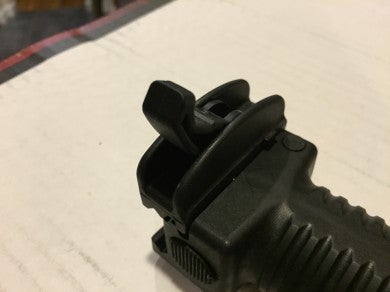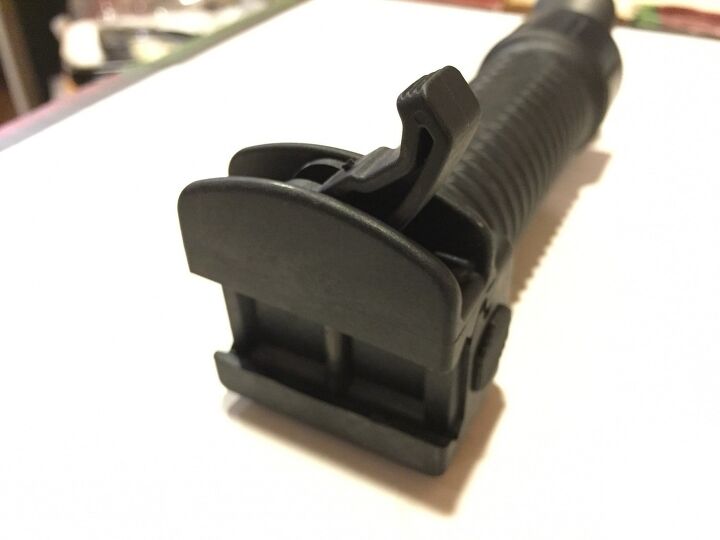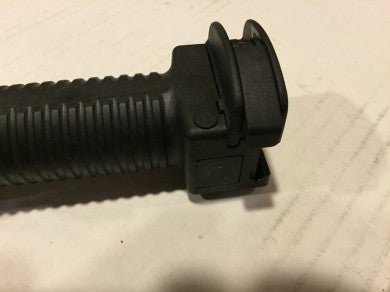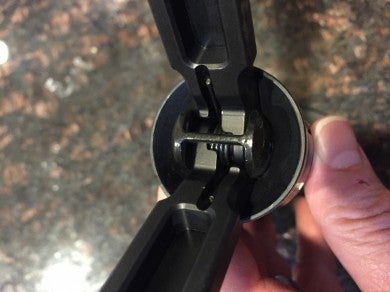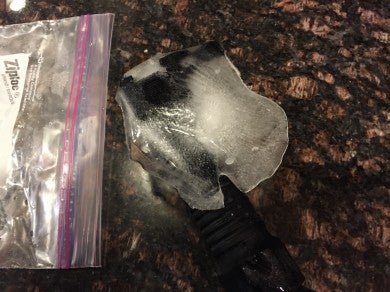When I first learned to shoot a long gun, we didn’t have forward grip devices, nor the “C” grip technique (not that they weren’t available in general, just not to me). Our push/pull method involved the forward hand gripping the front of the magazine well. A handle on the front of the gun was something seen in old movies showcasing the Prohibition.
While doing our ramp up training prior to deploying we had pretty bare rifles, basically an EOTech. Right before we deployed, we were issued a whole bunch of toys, including the Surefire Vertical Foregrip (though I can’t recall specific model; it had the super bright white light, and a couple of red LEDs). It was seriously heavy. It beat having an additional light, but it was awkward and I just never got used to it. It was “in the way”.
We also had access to an early version of a Grip Pod. The only thing I really remember about it was that it was a lot lighter than the Surefire (utilized as a grip). I also distinctly remember one of them shearing at the terminal juncture where the legs join when deployed (though I don’t know specifically what caused it, aside from being handled by a Marine).
Fast forward to today. Mark at GPSI expedited a new “beefy” version (the GPS-SAW-CL) to me just in time for a “long-range” 3-Gun match I was competing in. I knew there was a good possibility I was going to be shooting out to 400 meters and thought the match would be a good place to test it out if we had to go prone. Most of the previous prone shooting I had done involved using the magazine as a “monopod” (MagPul PMag FTW). Planting on the magazine has always worked pretty well, but is obviously not the intended purpose of the magazine, and depending on how you apply force (or what kind of magazine you are using), could induce a malfunction.
The model I was sent, the GPS-SAW-CL, is technically designed for use on actual SAWs (Squad Automatic Weapons) or other large man-portable weapons systems. It attaches to any picatinny rail system, so I figured my PWS Modern Musket would handle it fine, since neither my editors, nor GPSI, was kind enough to send me a SAW so I could run it with the platform for which it was intended.
Operation

Actuation button
It has a easy to hit button on the rear of the handle that makes the bipod eject from the bottom with a nice, satisfying “kerchunk”. I took some video showing it’s operation:
One of the differences in this version is that it has a quick release system (the “Cam Lever”) which should allow the user drop it in under a second. You can also control the tension of the lever (allowing you to make it easier or tougher to disconnect it).
Observations
I was pleasantly surprised. I’ve started using a “C” grip when holding the fore-end of my rifle (so I can be like the other cool kids); the Grip Pod did not interfere. I’m sure that has to do with my placement of the Grip Pod on the lower rail. Contrast that with something like the Surefire (with light) which could disrupt that hand placement depending on how you grip the front of your weapon.
The GPS-SAW-CL is very solidly constructed. The body is polymer while the legs are a solid 7075-T6 aluminum. The spring mechanism is also pretty solid. I actuated it about 100 times with no degradation of performance.
Because I’m a jerk, I poured some playground sand into the mechanism, closed it up (to the sound of some gritty grinding), and actuated it. No problems. It appeared to kick out most of the crap I dumped in it. It didn’t have the silky smooth sound again until I rinsed it out with a garden hose. I would think that long term nasty inside of it would eventually degrade the components, but you should be maintaining all parts of your kit. Right?
I also filled it full of water and put it in the freezer. It was actually a pain in the a** to do, as it kept shedding the water as I was pouring it in (which is clearly a good thing). I finally put it in a ziplock. With this test, I did have a problem. I froze the button side and had to chip the ice away to even touch the button.
Apparently I had gotten enough water into the mechanism that it was frozen solid and I could not depress the button. I let it sit for about 15 minutes and then it worked fine (there was still some ice on the body and the joint was still frosty). There does not appear to be any long term effects (so the polymer held up to the cold and the internal mechanism did not appear to be affected by the ice).
As you would expect, a bipod provides much more stability than a monopod (or, perish the thought, no grounding at all), when shooting from the prone position. In this, the Grip Pod performed flawlessly. If only it made my skill better…
I’m not sure about the utility of the quick disconnect in a combat situation (but I’m not terribly imaginative today). Since the intended use is technically on a SAW (or other large man-portable weapon), the only time I could see that feature being useful would be if the deployment mechanism failed or was damaged (and based on how beefy this thing is, I would not expect anything short of a direct impact would damage it). It’s not like you are going to be switching from suppressive fire to clearing rooms (with a heavy weapon), and the broomstick would suddenly be in the way. Maybe if you wanted to brace against the top of a wall, or sandbag, then removing the Grip Pod would be useful? Can any of you readers think up a scenario?
I can see some uses for that feature on a battle rifle, though, but more in conceptual relation to “quick connect” rather than “disconnect”. For instance, where you have the Grip Pod in a pouch and have to set up an overwatch. Then you can slap it on for some added stability. And remove it when it is time to move out again.
In relation to say a competition, though, I can definitely see a use. A scenario that comes to mind would be transitioning from a long range shot to close in targets, potentially from behind a barricade. Maybe it is worthwhile to drop it to reduce the weight at the end of the rifle (or because it interferes with how you shoot in positions other than prone). Unfortunately at the 3-Gun competition where I tested and evaluated the Grip Pod, we did short range with a transition to long for the final shots, so I didn’t get to test that theory. So long as the manipulation didn’t cost you time, it probably would end up as a wash.
Per GPSI, you should be able to ditch the Grip Pod in under a second. I was not able to ditch it quite that fast, but I was fairly close after a little bit of practice. With some tuning to the tension, I could probably shave a little more time.
Technical Specs
Weight: 9oz
Height (collapsed): 6.25″
Height (expanded): 8.5″
Diameter: 1.25″
MSRP: $180.00
Conclusion
I personally liked the Grip Pod. As I mentioned, my last experience was observational. I hadn’t used one specifically and didn’t really like having anything forward on my rifle that hung down. After my experience with this item, I think that it is a well constructed accessory. I know a number of people that swear by them (including a buddy that was recently down range).
If you are going to have a vertical fore grip, I can’t think of any reason not to endorse this product. It performed well during my test and handled sand and ice pretty well (just make sure the button isn’t encased in frozen water). I do imagine lava would cause it problems, so YMMV in that case. 🙂
If you have any experience with any of the Grip Pod products, please comment below. If you like their products you can follow them on Facebook (they have a ton of pictures of it in action) or on Twitter and get updates on new products.
 Your Privacy Choices
Your Privacy Choices

